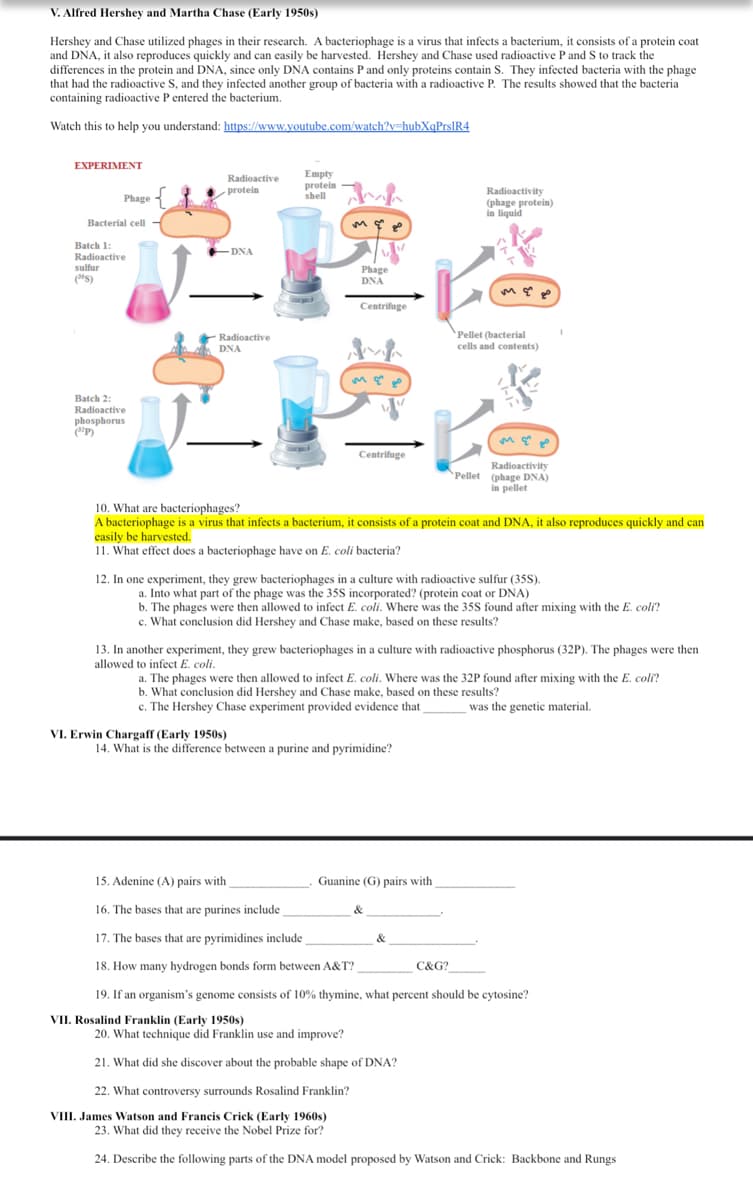12. In one experiment, they grew bacteriophages in a culture with radioactive sulfur (35S). a. Into what part of the phage was the 35S incorporated? (protein coat or DNA) b. The phages were then allowed to infect E. coli. Where was the 35S found after mixing with the E. coli? c. What conclusion did Hershey and Chase make, based on these results?
12. In one experiment, they grew bacteriophages in a culture with radioactive sulfur (35S). a. Into what part of the phage was the 35S incorporated? (protein coat or DNA) b. The phages were then allowed to infect E. coli. Where was the 35S found after mixing with the E. coli? c. What conclusion did Hershey and Chase make, based on these results?
Biology Today and Tomorrow without Physiology (MindTap Course List)
5th Edition
ISBN:9781305117396
Author:Cecie Starr, Christine Evers, Lisa Starr
Publisher:Cecie Starr, Christine Evers, Lisa Starr
Chapter6: Dna Structure And Function
Section: Chapter Questions
Problem 1DID
Related questions
Question
#12 pls

Transcribed Image Text:V. Alfred Hershey and Martha Chase (Early 1950s)
Hershey and Chase utilized phages in their research. A bacteriophage is a virus that infects a bacterium, it consists of a protein coat
and DNA, it also reproduces quickly and can easily be harvested. Hershey and Chase used radioactive P and S to track the
differences in the protein and DNA, since only DNA contains Pand only proteins contain S. They infected bacteria with the phage
that had the radioactive S, and they infected another group of bacteria with a radioactive P. The results showed that the bacteria
containing radioactive P entered the bacterium.
Watch this to help you understand: https://www.youtube.com/watch?v=hubXqPrsIR4
EXPERIMENT
Empty
protein
shell
Radioactive
protein
Radioactivity
(phage protein)
in liquid
Phage
Bacterial cell -
Batch 1:
- DNA
Radioactive
sulfur
(s)
Phage
DNA
Centrifuge
Pellet (bacterial
cells and contents)
Radioactive
DNA
Batch 2:
Radioactive
phosphorus
(P)
Centrifuge
Radioactivity
Pellet (phage DNA)
in pellet
10. What are bacteriophages?
A bacteriophage is a virus that infects a bacterium, it consists of a protein coat and DNA, it also reproduces quickly and can
easily be harvested.
11. What effect does a bacteriophage have on E. coli bacteria?
12. In one experiment, they grew bacteriophages in a culture with radioactive sulfur (35S).
a. Into what part of the phage was the 35S incorporated? (protein coat or DNA)
b. The phages were then allowed to infect E. coli. Where was the 35S found after mixing with the E. coli?
c. What conclusion did Hershey and Chase make, based on these results?
13. In another experiment, they grew bacteriophages in a culture with radioactive phosphorus (32P). The phages were then
allowed to infect E. coli.
a. The phages were then allowed to infect E. coli. Where was the 32P found after mixing with the E. coli?
b. What conclusion did Hershey and Chase make, based on these results?
c. The Hershey Chase experiment provided evidence that
was the genetic material.
VI. Erwin Chargaff (Early 1950s)
14. What is the difference between a purine and pyrimidine?
15. Adenine (A) pairs with
Guanine (G) pairs with
16. The bases that are purines include
&
17. The bases that are pyrimidines include _
&
18. How many hydrogen bonds form between A&T?
C&G?
19. If an organism's genome consists of 10% thymine, what percent should be cytosine?
VII. Rosalind Franklin (Early 1950s)
20. What technique did Franklin use and improve?
21. What did she discover about the probable shape of DNA?
22. What controversy surrounds Rosalind Franklin?
VIII. James Watson and Francis Crick (Early 1960s)
23. What did they receive the Nobel Prize for?
24. Describe the following parts of the DNA model proposed by Watson and Crick: Backbone and Rungs
Expert Solution
This question has been solved!
Explore an expertly crafted, step-by-step solution for a thorough understanding of key concepts.
This is a popular solution!
Trending now
This is a popular solution!
Step by step
Solved in 4 steps

Knowledge Booster
Learn more about
Need a deep-dive on the concept behind this application? Look no further. Learn more about this topic, biology and related others by exploring similar questions and additional content below.Recommended textbooks for you

Biology Today and Tomorrow without Physiology (Mi…
Biology
ISBN:
9781305117396
Author:
Cecie Starr, Christine Evers, Lisa Starr
Publisher:
Cengage Learning

Biology: The Dynamic Science (MindTap Course List)
Biology
ISBN:
9781305389892
Author:
Peter J. Russell, Paul E. Hertz, Beverly McMillan
Publisher:
Cengage Learning

Concepts of Biology
Biology
ISBN:
9781938168116
Author:
Samantha Fowler, Rebecca Roush, James Wise
Publisher:
OpenStax College

Biology Today and Tomorrow without Physiology (Mi…
Biology
ISBN:
9781305117396
Author:
Cecie Starr, Christine Evers, Lisa Starr
Publisher:
Cengage Learning

Biology: The Dynamic Science (MindTap Course List)
Biology
ISBN:
9781305389892
Author:
Peter J. Russell, Paul E. Hertz, Beverly McMillan
Publisher:
Cengage Learning

Concepts of Biology
Biology
ISBN:
9781938168116
Author:
Samantha Fowler, Rebecca Roush, James Wise
Publisher:
OpenStax College

Biology: The Unity and Diversity of Life (MindTap…
Biology
ISBN:
9781337408332
Author:
Cecie Starr, Ralph Taggart, Christine Evers, Lisa Starr
Publisher:
Cengage Learning


Biology: The Unity and Diversity of Life (MindTap…
Biology
ISBN:
9781305073951
Author:
Cecie Starr, Ralph Taggart, Christine Evers, Lisa Starr
Publisher:
Cengage Learning